How to Become the US President: A Step-by-Step Guide
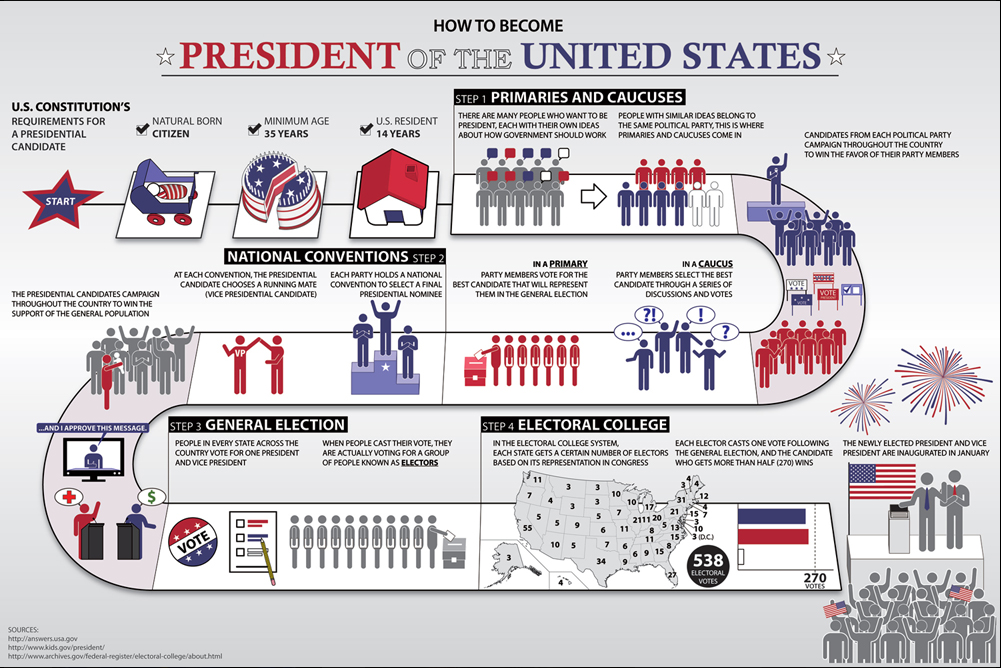 A step-by-step chart of how to become US President
A step-by-step chart of how to become US President
Source: Shahed Syed, www.shah3d.com
| 1. Meet Eligibility Guidelines Set by the US Constitution |
Article II of the United States Constitution establishes the Executive Branch of the Government, including the President, Vice-President, and other executive officers. Within Article II, rules are set as to who can become President and how a President is elected:
"Article II
Section 1. The executive power shall be vested in a President of the United States of America. He shall hold his office during the term of four years, and, together with the Vice President, chosen for the same term, be elected, as follows:
...No person except a natural born citizen, or a citizen of the United States at the time of the adoption of this Constitution, shall be eligible to the office of President neither shall any person be eligible to that office who shall not have attained to the age of thirty five years, and been fourteen Years a resident within the United States."
United States Constitution, Sep. 17, 1787
|
| 2. Test the Water: Pre-Candidacy Process |
"Serious candidates for president must begin preparing for the election years in advance. The first decision potential candidates and their families face is whether or not they are suited for the demands of the office and willing to make the personal sacrifices necessary to win the election. The next step usually involves forming political action committees to broaden a candidate's visibility, to test the candidate's appeal nationwide, and to raise money for increasingly expensive campaigns. Candidates also establish exploratory committees whose job it is to 1) seriously consider the candidate's chances of becoming president, 2) suggest possible campaigns themes and slogans, 3) write speeches and position papers, 4) seek endorsements from powerful individuals and groups, 5) recruit professional and volunteer staff, 6) begin organizing state campaigns in key states, 7) hire pollsters and consultants, and 8) develop media appeals."Thomas S. Vontz and William A. Nixon, "Teaching About Presidential Elections," Indiana University at Bloomington, Center for Social Studies and International Education website, Aug. 2000
|
| 3. Declare Candidacy & File Applications with Federal Election Commission |
The Federal Election Commission (FEC), created by Congress to administer and enforce the Federal Election Campaign Act (FECA) - the statute that governs the financing of federal elections, defines the process of registering a candidacy for President in the following manner:
"If you are running for the U.S. House, Senate or the Presidency, you must register with the FEC once you (or persons acting on your behalf) receive contributions or make expenditures in excess of $5,000. Within 15 days of reaching that $5,000 threshold, you must file a Statement of Candidacy authorizing a principal campaign committee to raise and spend funds on your behalf. Within 10 days of that filing, your principal campaign committee must submit a Statement of Organization. Your campaign will thereafter report its receipts and disbursements on a regular basis."
"Quick Answers to Candidate Questions," www.fec.gov (accessed Aug. 29, 2011) |
|
"Filing papers with the FEC usually coincides with announcements by candidates that they have formed an 'exploratory committee' to investigate the possibility of a presidential run. Even if it's clear that the candidates have every intention of running for president, this exploratory committee provides an escape hatch should they decide the time's not right to run...
From the perspective of the officials at the FEC who regulate how candidates finance their campaigns, announcing an exploratory committee is the same thing as announcing a full-fledged campaign for the presidency. The reason is that once a candidate starts raising funds for a presidential bid, everything counts toward the legal limits on contributions and spending, provided the candidate intends to participate in the public financing system...
Raising lots of money early in the game shows that a candidate is a serious contender and therefore helps raise even more money. Candidates need to file quarterly financial reports with the FEC, and these are public records. So all interested players can immediately see who is doing well in 'the invisible primary.'"
"Choosing the President 2004," League of Women Voters website, 2003
|
| 4. Fundraise and Campaign |
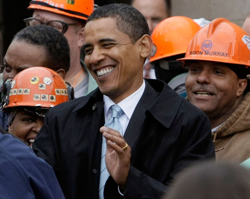 Democratic US presidential hopeful Senator Barack Obama (D-IL) greets US Steel Corp. workers in Braddock, PA during his 2008 campaign
Source: "Barack Obama Takes Campaign Bus Tour through Pennsylvania," www.zimbio.com, Mar. 28, 2008 "Presidential campaigns today are grueling marathons that take candidates by air from New York to Chicago to San Francisco and back again in a single day. On the campaign trail they typically make speeches, kiss babies, shake hands, pose for photographs, and find other ways to connect with the 'average' American. Candidates must raise millions of dollars from the party faithful and corporate leaders, ride buses through the hinterland, and rub shoulders with farmers, factory workers, veterans, and soccer moms...They must paint pictures of a better America, make passionate appeals to reason, and stake a claim for moral leadership. Not for the faint of heart, the modern presidential campaign tests the mettle of those who would live in the White House."
The American Presidency: A Glorious Burden, Lonnie G. Bunch, 2000
"The process The process by which American presidents are chosen has almost no resemblance to the ways in which other democratic countries select their chief executives...
[A] U.S. presidential campaign officially spans nine months and actually starts much earlier. It includes not only a general election but also a series of state caucuses and primary elections in which candidates essentially campaign as individuals, outside the party system...
The major justification for Americas elaborate presidential election system is legitimacy - the idea that the voters must choose the party nominees as well as the final winner if the outcome is truly to reflect the people's choice. Because of popular participation in the nominating process, presidential campaigns are necessarily long and involve large fields of contending candidates...
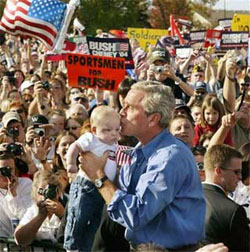 President George W. Bush kisses a baby during his 2004 campaign President George W. Bush kisses a baby during his 2004 campaign
Source: "President George Bush Baby Kiss," prezbaby.com, 2004
Most presidential contenders are not well known to the nation's voters before the campaign, and many of them have no significant record of national accomplishment. They enter the race out of personal ambition and with hopes that a strong showing in the earliest state contests will propel them into the national spotlight."
The American Democracy, Thomas E. Patterson, 1990
"Why is it so expensive to run for president today? It costs money to raise money, something candidates have to do during their pre-candidacy phase, during the phase when they are officially seeking their party's nomination and, increasingly, during the presidential election as well. Identifying potential donors and supporters, contacting them, and getting them to contribute, as well as to the polls, is expensive. Moreover, candidates are forced to campaign simultaneously in several states. To do so, they need to use the electronic media, design advertisements, and purchase time to air them. This too is costly."
The Road to the White House 2000: The Politics of Presidential Elections, Stephen J. Wayne, 2000
|
| 5. Party Primaries, Caucuses, and Delegates |
|
| Primaries |
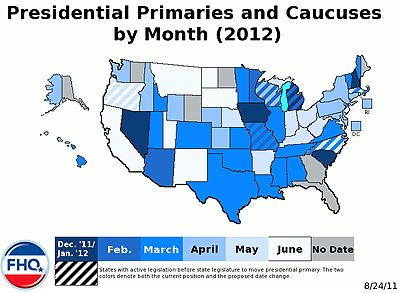 (Click to enlarge)
Map of the 2012 presidential primaries and caucuses by month and state
Source: "The 2012 Presidential Primary Calendar," frontloading.blogspost.com, Aug. 24, 2011
There are two main types of primaries, closed or open, that determine who is eligible to vote in the primary. In a closed primary a registered voter may vote only in the election for the party with which that voter is affiliated. For example a voter registered as Democratic can vote only in the Democratic primary and a Republican can vote only in the Republican primary. In an open primary, on the other hand, a registered voter can vote in either primary regardless of party membership. The voter cannot, however, participate in more than one primary. A third less common type of primary, the blanket primary, allows registered voters to participate in all primaries.
In addition to differences in which voters are eligible to vote in the primary, there are differences in whether the ballot lists candidate or delegate names. The presidential preference primary is a direct vote for a specific candidate. The voter chooses the candidate by name. The second method is more indirect, giving the voter a choice among delegate names rather than candidate names. As in the caucus, delegates voice support for a particular candidate or remain uncommitted.
In some states a combination of the primary and caucus systems are used. The primary serves as a measure of public opinion but is not necessarily binding in choosing delegates. Sometimes the Party does not recognize open primaries because members of other parties are permitted to vote.""How Does the Primary Process Work?," www.vote-smart.org (accessed Aug. 29, 2011) |
|
|
"Presidential caucuses and primaries differ from state to state, as do the rules and qualifications for getting on the ballot. Generally, a state presidential caucus is a multilayered system of meetings usually attracting only dedicated party members who elect delegates to represent them in the next stage of the election process. There are two types of state primaries. In the first type, voters directly vote for the person they want to nominate for the presidency. In the second type, voters elect delegates to the national nominating convention. Since 1956 these state contests have determined each party's nominee for the presidency. Traditionally, Iowa conducts the first caucus and New Hampshire the first primary, giving these two smaller states significant influence over the process."Thomas S. Vontz and William A. Nixon, "Teaching About Presidential Elections," Indiana University at Bloomington, Center for Social Studies and International Education website, Aug. 2000
|
| Caucuses |
"Caucuses were the original method for selecting candidates but have decreased in number since the primary was introduced in the early 1900's. In states that hold caucuses a political party announces the date, time, and location of the meeting. Generally any voter registered with the party may attend. At the caucus, delegates are chosen to represent the state's interests at the national party convention. Prospective delegates are identified as favorable to a specific candidate or uncommitted. After discussion and debate an informal vote is taken to determine which delegates should be chosen." "How Does the Primary Process Work?," www.vote-smart.org (accessed Aug. 29, 2011)
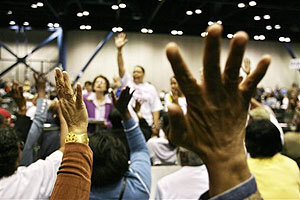 Members of Precinct 379 in Houston, TX vote at a Mar. 29, 2008 caucus to select 67 delegates to the Democratic national convention Members of Precinct 379 in Houston, TX vote at a Mar. 29, 2008 caucus to select 67 delegates to the Democratic national convention
Source: "Fighting for Every Texas Delegate," www.time.com, Mar. 31, 2008
"Caucus, a general term for a policymaking meeting of members of a political party. The term has various shades of meaning, depending on the nature of the business transacted at such a meeting. Undertones of disrepute are associated with the word because of the early American practice of holding clandestine caucuses to select candidates and determine issues without public discussion.
The congressional caucus for nominating U.S. presidential candidates in the first quarter of the 19th century was later discredited and gave way to national party conventions. Nominating caucuses in state legislatures gave way to conventions and later to direct primary elections. Legislative caucuses on the national and state levels in the United States remain useful tools for determining party strategy, but their decisions are not necessarily binding on legislators.""Caucus," ap.grolier.com (accessed July 3, 2007)
|
| Delegates |
|
|
| Democrats |
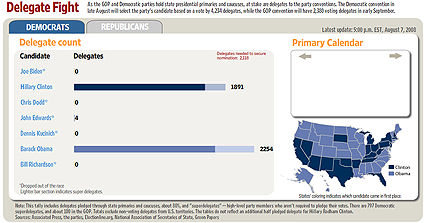 (Click to enlarge) (Click to enlarge)
Democratic party delegate count for the 2008 presidential election
Source: "Delegate Fight," Wall Street Journal website, Aug. 7, 2008
"To become the Democratic nominee for president, a candidate has to be nominated by a majority of delegates attending the Democratic National Convention [in Charlotte, NC, Sep. 1-4, 2012]."
What types of Democratic delegates are there?
"The Democratic Party has two types of delegates: Pledged and superdelegates...
A pledged delegate is elected or chosen on the state and local level with the understanding that they will support a particular candidate at the convention.
However, pledged delegates are not actually bound to vote for the candidate. Consequently, candidates are allowed on a state-by-state basis to review lists of delegates who have pledged their support and can delete anyone whose support they consider unreliable.
Superdelegates [created in 1982]... are usually Democratic members of Congress, governors, national committee members or party leaders (such as former presidents and vice presidents). They are not required to indicate a preference for a candidate, nor do they compete for the privilege like pledged delegates..."
[Read a complete list of the 2008 Superdelegates]
How are Democratic delegates awarded after a primary or caucus is held?
"The Democratic Party uses proportional representation to decide how many pledged delegates are awarded to each candidate.
For instance, a candidate who wins 40 percent of the vote in a state's primary would essentially win 40 percent of that state's pledged delegates. A second-place finisher in that primary who wins 30 percent of the vote essentially gets 30 percent of the pledged delegates.
However, a candidate has to receive at least 15 percent of the vote to get any pledged delegates...
There is no official process to win superdelegates because they can vote for whomever they please. But a candidate can use whatever powers of persuasion they have at their disposal to win the support of a superdelegate."
"Why Delegates Matter in the Presidential Race," CNN.com, (accessed Aug. 29, 2011)
["Pledged delegate" and "Superdelegates" bolded by ProCon.org]
[Read our 2008 Democratic Party State-by-State Primary and Caucus Guide]
What happens to Democratic delegates who have pledged their votes to a candidate who has dropped out of the race?
"When a candidate decides to leave the presidential race, they are entitled to keep any district-level delegates that were awarded to them and any district-level delegates that might be awarded to them in future contests. If pledged PLEO [party leader and elected official] delegates and at-large delegates have been selected prior to the candidate withdrawing from the race, they are also allowed to keep those delegates. However, if a candidate leaves the race prior to the selection of pledged PLEO and at-large delegates, those delegate positions are reallocated to the candidates still in the race.
Delegates are not 'bound' to vote for the candidate they were elected to represent. They can, and have in the past, cast a vote for another presidential candidate at the Convention. As a sign of good faith, most former candidates will "release” their delegates from voting for them; however, this is not required, and only has a symbolic meaning to it. Delegates can vote for another presidential candidate without being 'released.'"
"DELEGATES 101: Frequently Asked Questions about the Presidential Nominating Process,"
Democratic National Committee document emailed to ProCon.org, Feb. 14, 2008 |
|
|
| Republicans |
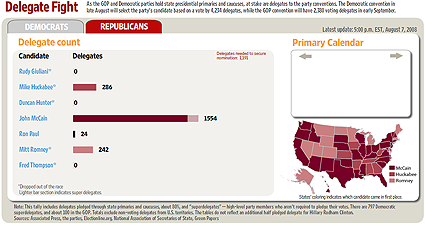 (Click to enlarge)
Republican Party delegate count for the 2008 presidential election
Source: "Delegate Fight," Wall Street Journal website, Aug. 7, 2008
"To become the Republican nominee for president, a candidate has to be nominated by a majority of delegates attending the Republican National Convention [in Tampa Bay, FL, Aug. 25-28, 2012]."
What types of Republican delegates are there?
"The Republican Party has two types of delegates: Pledged and unpledged...
[P]ledged delegates... have to indicate support for a particular candidate at the convention. They are usually elected or chosen on the state and local level.
Unpledged delegates...are not required to indicate a preference for a candidate."
How are Republican delegates awarded after a primary or caucus is held?
"A majority of Republican unpledged delegates are elected just like pledged delegates and are likely to be committed to a specific candidate. A sizable minority of unpledged delegates automatically become delegates by virtue of their status as either a party chair or a national party committee person. This group is known as unpledged RNC [Republican National Committee] member delegates....
State parties decide how pledged delegates are awarded to each candidate during the Republican nomination process.
Many states use a 'winner take all' system. Some states use a proportional representation system in which a candidate's share of the popular vote is the percentage of pledged delegates they are awarded.
The Republican National Committee does not require a 15 percent threshold, but individual state parties may have a threshold.
The unpledged RNC member delegates -- party chairmen and committee persons who are not elected delegates -- are free to vote for any candidate and are not bound by the electoral results of their state.
The unpledged delegates who are elected or chosen -- though they are technically free to vote for any candidate -- are likely to be committed to a specific candidate."
"Why Delegates Matter in the Presidential Race," CNN.com (accessed Aug. 29, 2011)
["Pledged" and "Unpledged delegates" bolded by ProCon.org]
[Read our 2008 Republican Party State-by-State Primary and Caucus Guide]
What happens to Republican delegates who have pledged their votes to a candidate who has dropped out of the race?
"Throughout the country, there are more than 280 Romney delegates, but different states have different rules. For instance, Loomis [Burdett Loomis, University of Kansas Political Science Professor] says, the two dozen Romney delegates in his home state of Michigan have been told that they are free to vote as they like. In Massachusetts, the former governor still has control of his 22 delegates. And in some states, GOP delegates won't even be selected until upcoming county conventions." "What Happens to Delegates for Romney, Edwards?," Alex Cohen, National Public Radio (NPR) online, Feb. 13, 2008 |
|
|
| Third Party |
| Third parties have national conventions, and they do participate in primaries and caucuses although not necessarily in every state. Each party varies in how they select delegates. Below we highlight the delegate process for the Constitution Party, Green Party, Libertarian Party, and Reform Party. These political parties were included based on 2004 Presidential election ballot access. Each of these third parties had candidates on the ballot in enough states to have a chance of winning the 270 electoral votes needed to be elected president. |
The Constitution Party
The Constitution Party selects its delegates in state primaries and caucuses. The number of delegates awarded within each state is loosely based on the number of electoral college votes and the level of organization for the party within the state, i.e. the number of state party members and their success at electing party members to local and state offices.
Green Party
The Green Party selects its delegates in state primaries and caucuses. The number of delegates in each state is based on the state's electoral votes, the number of votes the Green Party received in the most recent major statewide election, the number of Green Party members elected to office during the most recent election, and the number of state delegates on the National Coordinating Committee.
Libertarian Party
The Libertarian Party selects its delegates in state primaries and caucuses. The number of delegates in each state is determined by that state's Libertarian Party membership and the number of votes the nationally nominated Libertarian Presidential candidate received from that state in the prior presidential election.
Reform Party
The Reform Party selects its delegates in state primaries and caucuses. The number of delegates in each state's delegation is equal to the number of Congressional Districts of the State plus three at-large delegates. |
[Note: We normally quote other organizations when presenting data; however, we were unable to find a suitable quote describing how third parties select delegates, so we opted to create our own description in this case.]
[See the results of all the Democratic, Republican, and Third Party primaries in the 2008 presidential election]
|
| 6. Party Conventions |
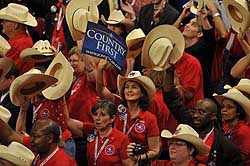 Members of the Texas delegation at the 2008 Republican National Convention in St. Paul, MN Members of the Texas delegation at the 2008 Republican National Convention in St. Paul, MN
Source: "Photo Galleries," apps.detnews.com, Sep. 1-4, 2008
"Presidential Conventions," HistoryCentral.com (accessed on Aug. 29, 2011)
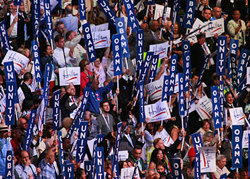 2008 Democratic National Convention in Denver, CO 2008 Democratic National Convention in Denver, CO
Source: "2008 Democratic National Convention," www.iop.harvard.edu, Aug. 25-28, 2008
Preliminary decisions on the convention are made by the party's national committee, usually on the recommendation of its chair and appropriate convention committees. An incumbent president normally exercises considerable influence over many of these decisions: the choice of a convention city, the selection of temporary and permanent convention officials, and the designation of the principal speakers. Both the Democrats and the Republicans have traditionally turned to national party leaders, primarily members of Congress, to fill many of the positions" The Road to the White House 2000: The Politics of Presidential Elections, Stephen J. Wayne, July 3, 2007
"The Changing Character of Conventions
In the past, the national convention served as a decision-making body, actually determining the party's nominee...
Two significant changes have occurred in recent decades. First, most of the national convention delegates are now selected by voters in primary contests rather than by party caucuses and meetings. Second, with the advent of television, conventions have become tightly scripted made-for-TV spectacles. Each party seeks to present itself in the best possible light and to demonstrate a united front rather than to hash out its differences...
The conventions may have been reduced to rubber stamps, but they still fulfill a vital function in the life of the political parties. In many ways, the essence of a convention is what happens off of the convention floor. In the lead-up to the convention, the drafting of the party platform provides interests aligned with the party a forum to present their concerns. During the days of the convention itself, hundreds of events, caucuses, receptions, breakfasts, fundraisers, and parties take place in the hotels surrounding the convention hall. At the end of the convention, party activists return to their communities energized for the fall campaign and, if all goes well, the presidential ticket emerges with a convention bounce...
The major party conventions are funded by grants from the Presidential Election Campaign Fund (the $3 income tax check-off), by non-partisan, non-profit host committees, and to a lesser degree by local taxpayers. For their 2008 conventions, the Democrats and Republicans each received grants of about $16.4 million. On June 16, 2007 the FEC certified the Democratic and Republican parties were each entitled to receive $16,356,000 in public funds to put on their 2008 national conventions, and sent letters to the Secretary of the Treasury requesting the payments be made. (These grants, set out in the Federal Election Campaign Act, started at $2.2 million back in 1976 and were increased a couple of times in addition to being adjusted for cost-of-living increases)."
"Conventions," Eric M. Appleman, www.gwu.edu/~action (accessed Aug. 29, 2011)
|
| 7. General Election Campaign: The Final Candidates |
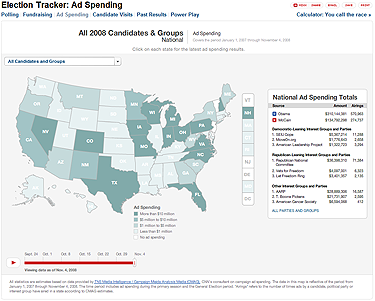 (Click to enlarge) Ad spending for all 2008 candidates and groups, Jan. 1, 2007-Nov. 4, 2008 (Click to enlarge) Ad spending for all 2008 candidates and groups, Jan. 1, 2007-Nov. 4, 2008
Source: "ElectionCenter2008," www.cnn.com, Nov. 4, 2008
The fall brings with it a number of strategic decisions for the candidates and their campaign organizations. But perhaps the most important decision facing the candidates as they approach the general election season is how to refine their message so it resonates with a majority of the American electorate... 'Shifting to the center,' as it is called, is often a tightrope walk for the candidates because they don't want to offend their primary supporters or make it appear as though they are abandoning their earlier commitments...
Today's presidential candidates essentially wage three campaigns at the same time. The first is the grassroots campaign. While the candidates themselves have little direct involvement in it, national campaign staff help to give it direction. It includes hundreds of local campaign headquarters and party organizations, from which volunteers and a few paid staff reach out into local communities. They register voters, make phone calls, send out mail, help friendly voters apply for absentee ballots, put up signs, do door-to-door canvassing, and get out the vote on Election Day...
The second level of campaigning is on the ground, and includes all of the candidate's appearances and speeches, as well as the appearances throughout the country of key supporters, from the candidate's spouse and children to the vice presidential nominee, Hollywood celebrities, and prominent party leaders... The third campaign in which the candidates are engaged is an on-the-air battle of radio and television commercials. This advertising is the most expensive line item in the campaign budget--an estimated one-third of the $1.5 billion spent on the 2000 presidential campaign. The advertising gives the candidates massive nation-wide exposure that they couldn't possibly achieve on the ground." "Choosing the President 2004," League of Women Voters website, 2003
|
| Death or Incapacity of a Candidate |
"If a presidential or vice-presidential candidate is incapacitated between a party's nominating convention and the meeting of the Electoral College [when the 'electors' meet to cast their votes in their state capitals on the first Monday after the second Wednesday of December], the party's central committee would gather to pick a substitute candidate...
...[I]f a candidate on the ticket dies or becomes incapacitated after the Electoral College vote in December but before the congressional certification of the results in January. During this period, does the country have a president-elect?...The most reasonable argument (bolstered by statutory history of the 20th Amendment, which deals with succession issues) would seem to be that the person who obtained the most electoral votes is the president-elect, even if Congress hasn't yet certified the votes.
The relevance of inquiring precisely when the next president becomes president-elect is that the 20th Amendment states that the vice president-elect becomes the president-elect if that person can't take the office at the beginning of his or her term. So, whenever the winning candidate becomes president-elect (and you can choose between the November general election date, the December Electoral College vote or the January congressional certification) is the point at which the succession is taken out of the party's hands and the Constitution kicks in -- making the vice president elect's ascension to the top of the ticket automatic.."
"Stumped," Andres Martinez, washingtonpost.com, July 1, 2008
|
| 8. Election Day: Winning the Popular and Electoral Votes |
"Presidential Elections
The President of the United States is elected by the Electoral College and not directly by the population. Each state is assigned electoral votes based on the number of senators and representatives that state has in Congress. Each state has two Senators. The number of representatives is determined by the state's population but is never less than 1. Thus small states with a small population are overly represented in the Electoral College. One candidate wins all of the electoral votes in all states except Maine and Nebraska. Their two electors are chosen by statewide popular vote and a single elector is chosen in each Congressional district.
When does the electoral college meet?
The Electoral College meets on the first Monday after the second Wednesday in December. Their votes are then counted again in the presence of Joint Meeting of Congress sixth day of January to certify the returns. The candidate that wins over 50% of the electoral votes becomes President of the United States.
Who are the members of the Electoral College?
The members of the electoral college are individual who are active in their party. They are pledged to vote for one or the other candidates. By law they are not required to vote for their pledged candidate but in fact always do.
What if no one wins the Majority of electoral votes?
In the case that no candidate wins the majority of electoral votes, the election is decided by the House of Representatives. The House of Representatives votes by state. Thus every state in the House of Representative gets one vote."
"Presidential Elections," HistoryCentral.com (accessed Aug. 29, 2011)
ELECTION DAY
On the first Tuesday after the first Monday of November, control of the presidential election finally passes into the hands of the American voter... In recent elections, states have also permitted a growing number of votes to be cast before Election Day. Under absentee and mail-in voting, people can mail in their ballots, and often do so a week or more before the official Election Day...
HOW DOES THE ELECTORAL COLLEGE WORK?
Under the Constitution, each state is authorized to choose electors for president and vice president; the number of electors per state is equal to the combined number of U.S. senators and representatives from that state. The Electoral College thus includes 535 electors from the states plus 3 electors from the District of Columbia, for a grand total of 538. When voters chose a presidential ticket including the presidential and vice presidential candidate, they are actually voting for electors pledged to this ticket. In all but two states, the ticket that wins a plurality of the votes wins all of that state's electors. To be elected to the presidency, a candidate must receive an absolute majority (270) of the electoral votes. The vice president is elected by the same indirect, state-by-state method, but the electors vote separately for the two offices...
MAKING IT OFFICIAL
 Inaugural ceremony of President Barack Obama, Washington, DC, Jan. 20, 2009 Inaugural ceremony of President Barack Obama, Washington, DC, Jan. 20, 2009
Source: "How We Got Here," Chicago Tribune website, Apr. 15, 2011
|
|
|
RECOMMENDED to you...
|
|
1
|
|
2
|
|
3
|
|
4
|
|
5
|
|
6
|
|
7
|
|
8
|
|
9
|
|
10
|
|
11
|
|
12
|
|
|
|

CITE THIS PAGE
Who is the author?
|
|
SHARE
|
|
